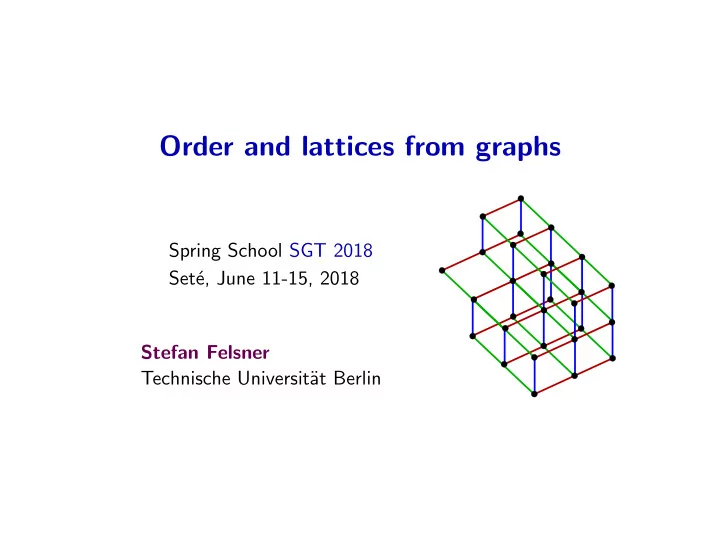

Order and lattices from graphs Spring School SGT 2018 Set´ e, June 11-15, 2018 Stefan Felsner Technische Universit¨ at Berlin
Outline Orders and Lattices Definitions The Fundamental Theorem Dimension and Planarity Lattices and Graphs α -orientations The ULD-Theorem ∆-Bonds and Further Examples Distributive Lattices and Markov Chains Coupling from the Past Mixing time on α -orientations
Finite Orders P = ( X , < ) is an order iff • X finite set • < transitive and irreflexive relation on X .
Lattices P = ( X , < ) an order. • Let x ∨ y be the least upper bound of x and y if it exists. • Let x ∧ y be the greatest lower bound of x and y if it exists. L = ( X , < ) is a finite lattice iff • L is a finite order • x ∨ y and x ∧ y exist for all x and y .
Lattices - the algebraic view L = ( X , ∨ , ∧ ) is a finite lattice iff • X is finite and for all a , b , c ∈ X and ⋄ ∈ {∨ , ∧} • a ⋄ ( b ⋄ C ) = ( a ⋄ b ) ⋄ c (associativity) • a ⋄ b = b ⋄ a (commutativity) • a ⋄ a = a (idempotency) • a ∨ ( a ∧ b ) = a and a ∧ ( a ∨ b ) = a (absorption) Proposition. The two definitions of finite lattices are equivalent via: ( x ≤ y iff x = x ∧ y ) and ( x ≤ y iff x = x ∨ y ) .
Distributive Lattice A lattice L = ( X , ∨ , ∧ ) is a distributive lattice iff a ∨ ( b ∧ c ) = ( a ∨ b ) ∧ ( a ∨ c ) and a ∧ ( b ∨ c ) = ( a ∧ b ) ∨ ( a ∧ c ) FTFDL. L is a finite distributive lattice ⇐ ⇒ there is a poset P such that that L is isomorphic to the inclusion order on downsets of P . L P { 1 , 2 , 3 , 5 } P 4 5 6 { 1 , 2 , 4 } 1 2 3 { 3 }
Linear Extensions A linear extension of P = ( X , < ) is a linear order L , such that • x < P y = ⇒ x < L y d d c d d c c c d b c d b b b c a a a a a a b b
Dimension of Orders I A family L of linear extensions is a realizer for P = ( X , < ) provided that ∗ for every incomparable pair ( x , y ) there is an L ∈ L such that x < y in L . The dimension, dim( P ), of P is the minimum t , such that there is a realizer L = { L 1 , L 2 . . . , L t } for P of size t .
Dimension of Orders II The dimension of an order P = ( X , < ) is the least t , such that P R t with the product ordering. is isomorphic to a suborder of I
Dilworth’s Imbedding Theorem (1950) L P P Theorem. dim( L P ) = width( P ). • Let C 1 , . . . , C w be a chain partition of P . R w by I → ( | I ∩ C 1 | , . . . , | I ∩ C w | ). Imbed L P in I • If P contains an antichain A of size w , then there is a Boolean lattice B w in L P . Hence dim( L P ) ≥ dim( B w ) = w .
Recommend
More recommend